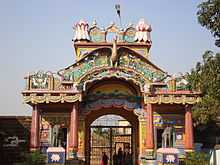Mahima Dharma
The Mahima Dharma (full name Satya Mahima Alekha Dharma or Satya Sanatan Mahima Dharma, "the true path of indescribable grace") is a socio-religious monotheistic practice primarily prevalent in Odisha and nearby states. It was started by people from the underprivileged castes in a caste-based Hindu society as a social reform against the dominance of Brahmanism. The practices has influcence of Buddhism and Jainism and Advaita Vedanta. The cult also believes in condemnation of all religious customs set by the rich and upper class societies.[1]
Founder
The founder of Mahima Dharma was the one and only Mahima Swami or Mahima Gosain.[2] For many years Mahima Gosain was in deep meditation in the caves at Himalaya. From there Swami travelled to many regions and at last appeared in Puri (Odisha) in 1826 as Dhulia Gosain, where Swami settled on dusty roads of Puri. People used to ask him queries on their well being and, surprisingly, it all happened to be true. It is believed once Swami was invited to Puri Mukti Mandap and there he confirmed Brahma is Nirguna and Sunya.
From Puri Swami moved to hill caves of Khandagiri, Dhauligiri, Nilagiri etc. near Bhubaneswar (capital of Orissa state). During that period Swami lived on water alone for 12 years and people used to call him Nirahari Gosain. In 1838 Swami moved to Kapilash hill of Dhenkanal district of Orissa and spent 21 days in Atma Yoga Samadhi (unification of human mind) with Balkal of kumbhi tree (bark of careya arborea) leaving his clothes on a huge round stone. A great seven-hooded snake spread its hood covering his head. The nearby area of the forest was illuminated by the luster of the body of Swami. On the 21st day a tribal, Sadananda of nearby Deogram village, witnessed the magnificent Atma Yoga Samadhi of Swami and served him fruits for 12 years during the stay of Swami at Kapilash hill. For this, Swami came to be known as Phalahari Gosain. The next 12 years Swami survived on cow's milk alone, rendered as service by the ruler of Dhenkanal, King Bhagirathi Bhramarbar Bahadur. Both the king and the queen had the opportunity to witness Swami on top of Kapilash hill and would serve him milk in new earthen pots.
Later, Swami moved to Kakanpada village of Rairakhol with his first disciple Sidha Govinda Baba. It is said he made an appearance to a blind Bhima Bhoi and blessed him with eyesight. Upon seeing the Swami, Bhima, with all his humbleness, prayed to the Swami to make him blind again as the torture of mankind was intolerable for him. Swami blessed him to compose a poem on Nirguna Brahma to spread the Mahima cult. After this Swami retired back to Kapilash hill. Many believe the journey of Swami to Rairakhol was through air, not by foot.
After spending 12 years in Kapilash hill, Mahima Prabhu travelled around 24 years as Brahmabadhuta (wandering mendicant of supreme order) and spread Mahima Dharma in Odisha and the neighboring states, before taking Samadhi at Joranda, Dhenkanal, of Odisha on the 10th day after the new moon of 1876. The place where Mahima Swami disappeared (merged Himself in the Mahanityapura) is called Mahima Gadi. It is the heart of all Mahima movement around world.[3]
Practices
The religion is essentially monotheistic in nature. Mahima religion strictly opposes the caste system and idol worship. The religion strictly forbids adultery, the consumption of any intoxicants, violence, and the consumption of any flesh. Food and water has to be taken before sunset. The Mahima devotee should leave his/her bed around 4am early morning and perform Saran/Darsan before sunrise. Saran/Darsan is the act of complete surrender of self to Mahima Prabhu. The same is repeated three times a day including noon and evening before sunset. They are sometimes misinterpreted as followers of Surya, the Sun god, which is not true.
The religion has a monastic order. Members of the monastic order, like Buddhist monks, do not constitute a priestly class and have no control over the lay practitioners. They have to lead a life of poverty, celibacy, piety and constant movement, as the monks are not allowed to sleep in the same place on two consecutive nights nor take meal twice from same house in any day. There is strict order of the Mahima Swami to avoid any kind of idol worship. The Supreme Lord of the indescribable grace (Alekha) is worshiped.
The Mahima principle is derived from Veda and Upanishads. It is believed by scholars that this might be a neo-Vedanta movement. In short, Mahima cult is a revivalism of the Vedantic thrust and a reformist movement of Odisha within the Sanatan Hindu fold.[4]
See also
- Satya Mahima Dharma
- Joranda Gadhi
References
- ↑ Mishra, R.N. "The Alekh Cult: A Religion of the Masses". Boloji.com. Retrieved 6 October 2014.
- ↑ "Mahima Dharma, Bhima Bhoi and Biswanathbaba".
- ↑ Satya Mahima Dharma Itihasa by Brahmabadhuta Biswanath Baba.
- ↑ Mahima Dharma Bhima Bbhoi Biswanathbaba
Further reading
- Satya Mahima Dharma Itihasa by Brahmabadhuta Biswanath Baba, 1–47
- Philosophy of Mahima Dharma by Brahmabadhuta Biswanath Baba (translated to English by Sri Sarbeswar Das)
- Mahima Dharmadhara by Prof. Satrughna Nath, 55–57
- Banerjee-Dube, Ishita. 2001. ‘Issues of Faith, Enactment of Contest: The Founding of Mahima Dharma in Nineteenth-Century Orissa’. In Kulke, H. and Schnepel, B. (eds.), Jagannath Revisited, New Delhi: Manohar, 149–177.
- Eschmann, Anncharlott 1978. "Mahima Dharma: An Autochthonous Hindu Reform Movement," in Eschmann A., Kulke, H. & Tripathi, C.G. (eds). The Cult of Jagannath and the Regional Tradition of Orissa, New Delhi: Manohar, 375–410.
- Guzy, Lidia 2002. Baba-s und Alekh-s – Askese und Ekstase einer Religion im Werden. Berlin: Weissensee Verlag.
| Wikimedia Commons has media related to Mahimaism. |
